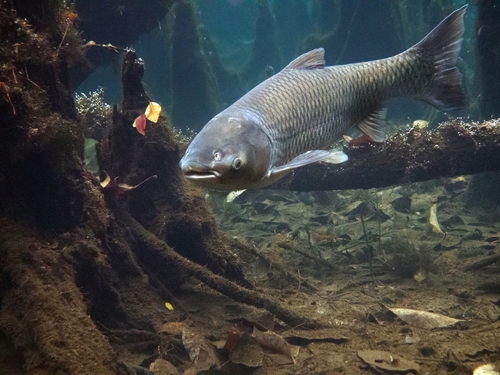
Grass Carp
The Atlantic Bluefin Tuna (Thunnus thynnus) is a magnificent, highly migratory species of tuna found in the Atlantic Ocean. Renowned for its size, speed, and power, it is a top predator and a highly prized catch in commercial fisheries. This species plays a crucial role in the marine ecosystem.
5 20 years
Lifespan
120 cm
Length
Least Concern
Conservation Status
15 km/h
Swimming speed
Herbivorous
Diet
Local Migration
Migration
Appearance Overview
The Atlantic Bluefin Tuna is renowned for its large, streamlined body, built for speed and endurance.
Color
Dark metallic blue above, silvery-white below
Body Shape
Torpedo-shaped, streamlined
Fins
Two dorsal fins, the first depressible; small finlets run down the back and belly to the tail
Keel
Strong lateral keel on the caudal peduncle
Length
Up to 13 feet (4 meters)
Weight
Up to 2,000 lbs (907 kg)
Diet
Carnivorous, feeding on a wide variety of fish, squid, crustaceans, and occasionally, eels.
Feeding Behavior
Highly active predator, using its speed and agility to chase down prey. They are also known to feed cooperatively, herding smaller fish into tight balls before attacking.
Social Behavior
Forms large schools, particularly during spawning and migration. These schools can be mixed with other tuna species.
Commercial Relevance
Extremely high value, particularly in the Japanese sushi and sashimi market, where a single fish can fetch hundreds of thousands of dollars.
Conservation measures
International fishing quotas, restrictions on gear types, minimum size limits, and time-area closures. Marine Protected Areas (MPAs) also offer some refuge.
Status
Endangered
Threats
Severe overfishing (historically and ongoing), illegal and unreported fishing, bycatch in other fisheries, and climate change impacting prey distribution and spawning grounds.
Habitat Distribution
Depth Range
0 - 3,280 feet (0 - 1,000 meters), but can dive much deeper
Geographic Range
Western and Eastern Atlantic Ocean, Mediterranean Sea, and formerly the Black Sea.
Preferred Environment
Temperate and subtropical waters; highly migratory, undertaking long trans-Atlantic migrations.
Reproduction and Life Cycle
Breeding Habits
Spawns in two main areas: the Mediterranean Sea and the Gulf of Mexico. Spawning occurs in warm waters, typically from April to June in the Gulf of Mexico and May to July in the Mediterranean.
Development Stages
Eggs are pelagic and hatch within a few days. Larvae are planktonic and develop rapidly, undergoing significant morphological changes as they grow. Juveniles form schools and gradually move to feeding grounds.
Fecundity
Highly fecund; a large female can produce up to 30 million eggs per spawning season.
Maturity Age
Reaches sexual maturity at around 4-5 years in the Mediterranean and 8-12 years in the Gulf of Mexico.
Faqs about Grass Carp
Where do Atlantic Bluefin Tuna live?
Atlantic Bluefin Tuna are found in the Atlantic Ocean, from the surface down to depths exceeding 3,000 feet.
Are Bluefin Tuna warm-blooded?
Yes, they are warm-blooded, unlike most fish. They have a special circulatory system that allows them to maintain a body temperature higher than the surrounding water.
How long do Bluefin Tuna live?
They can live up to 40 years, although many do not reach this age due to fishing pressure.
How fast can Bluefin Tuna swim?
Atlantic Bluefin Tuna are among the fastest fish in the ocean, capable of swimming at speeds up to 43 mph (70 km/h).
Why is the Atlantic Bluefin Tuna endangered?
The high demand for Bluefin Tuna in sushi and sashimi markets, coupled with their slow growth and late maturity, has made them vulnerable to overfishing. Their large size also makes them susceptible to being caught as bycatch.
Copyright @ Nature Style Limited. All Rights Reserved.
 English
English